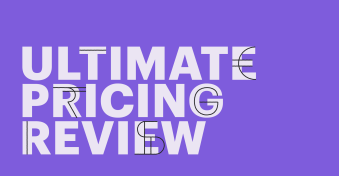Today’s electronic signature market is hyper-competitive.
DocuSign is considered to be the industry leader in digital signatures, but plenty of competitors have arisen in response to the high costs and sending limitations imposed by the platform.
Xodo Sign (formerly eversign) is one such contender.
In this article, we’ll take a closer look at how Xodo Sign and DocuSign compare so that you better determine which platform is the best fit for your business.
Let’s jump in.
Key takeaways
- Xodo Sign excels in affordability and user-friendliness, making it ideal for small to medium-sized businesses and individuals.
- DocuSign offers a more extensive feature set and robust integrations, catering to larger enterprises and complex workflows.
- Both platforms provide secure and legally binding e-signatures, ensuring compliance and peace of mind.
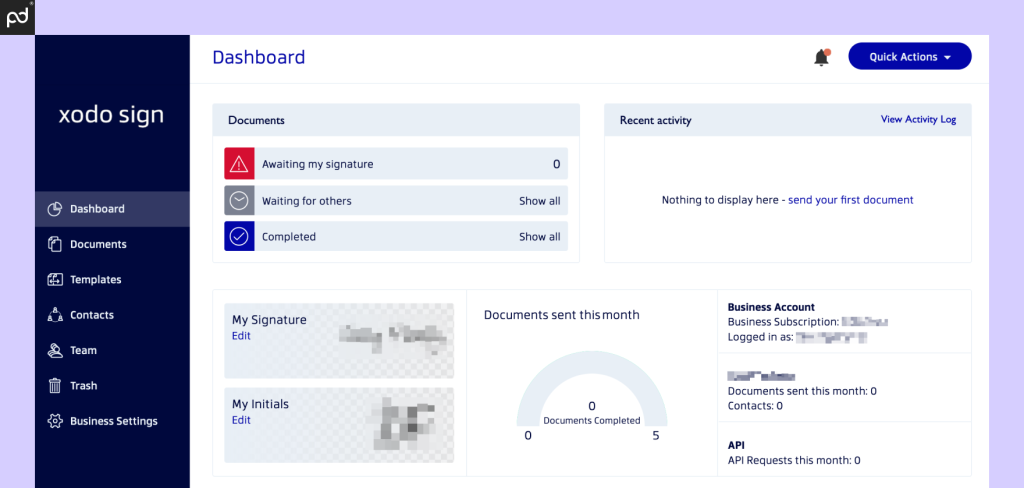
Xodo Sign
Pricing: Basic ($13); Professional ($50); Professional ($120). Enterprising pricing available. All pricing based on month-to-month commitment.
Ease of use: 8.3/10
Free trial: Free plan available.
Support: Knowledge base; support tickets.
Xodo Sign (formerly eversign) is a comprehensive cloud-based e-signature platform catering to businesses of all sizes.
The product fits naturally with Xodo’s other big product, Xodo PDF Studio, and can stand alone or be used in conjunction with it to add e-signing to the PDF editing suite.
By itself, Xodo Sign helps to streamline document workflows by helping users prepare, send, sign, and manage legally binding electronic documents.
The platform offers an intuitive, drag-and-drop interface and, like most digital signature tools, facilitates the entire digital signing process for all signatories.
You’ll also find an interesting collection of features in Xodo Sign’s plans.
Many of these features are offered by DocuSign and other platforms, but Xodo Sign may offer them early or in some limited capacity without the higher price tag demanded by other, competitive products.
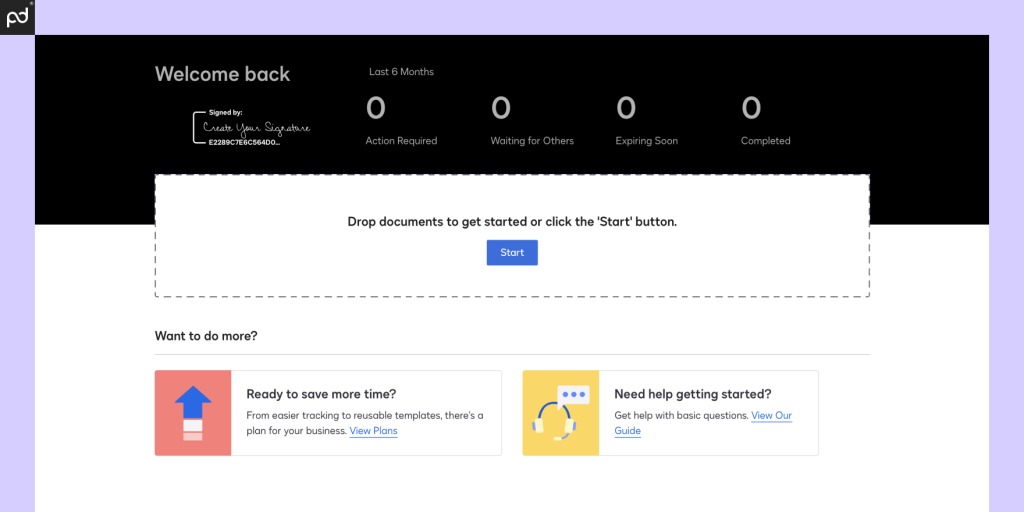
DocuSign
Pricing: Personal ($15); Standard ($45); Business Pro ($60). Enterprise pricing available. All pricing based on month-to-month commitment.
Ease of use: 9.0/10
Free trial: Yes; 30 days.
Support: Knowledge base; support tickets; additional support plans sold as separate packages.
DocuSign, a well-established player in the electronic signature market, enjoys widespread recognition and trust among businesses globally.
Its comprehensive feature set, extensive integrations, and user-friendly interface are key strengths.
With DocuSign, users can automate signing processes, securely store documents, and maintain detailed audit trails.
However, many of these features are now standard in other e-signature solutions — including Xodo Sign.
Despite its strong reputation, DocuSign also features high price points and certain limitations in transaction capabilities or overall functionality.
This is particularly true when compared to newer providers, many of whom offer e-signing as part of their platform feature set alongside other digital document solutions.
Xodo Sign vs DocuSign at a glance
Curious how DocuSign and Xodo Sign measure up to one another?
We’ll cover the differences in greater detail below, but here’s a closer look at the basic feature set offered by both platforms.
| Plan Details | DocuSign | Xodo Sign |
|---|---|---|
| Core product | ||
| E-signature capture | ✔︎ | ✔︎ |
| Real-time audit trail | ✔︎ | ✔︎ |
| Notifications | ✔︎ | ✔︎ |
| Language support | ✔︎ | ✔︎ |
| Mobile app | ✔︎ | ✕ |
| Reporting tools | ✔︎ | Limited |
| E-signing features | ||
| Signing order | ✔︎ | ✔︎ |
| Send to multiple recipients | ✔︎ | ✔︎ |
| Bulk send | ✔︎ | ✔︎ |
| In-person signing | ✔︎ | ✔︎ |
| Collaboration tools | ✔︎ | ✕ |
| Signer attachments | ✔︎ | ✔︎ |
| Payment gateway | ✔︎ | ✕ |
| Document prep | ||
| Drag & drop fields (PDF) | ✔︎ | ✔︎ |
| Create reusable templates | ✔︎ | 25 Templates |
| From-scratch document builder | ✕ | ✕ |
| Pre-built template library | ✕ | ✕ |
| Form creation | ✔︎ | ✕ |
| Custom branding | ✔︎ | ✔︎ |
| Integrations & API | ||
| Import & storage | ✔︎ | ✔︎ |
| CRM | ✕ | ✔︎ |
| Productivity | ✔︎ | ✔︎ |
| API | $ | ✕ |
| Support | ||
| Email / ticketing support | ✔︎ | ✔︎ |
| Chat support | ✕ | ✕ |
| Knowledge base | ✔︎ | ✔︎ |
| Phone | ✕ | ✕ |
| Premium support options | $ | ✕ |
For this chart, we compared DocuSign’s Business Pro plan to Xodo Sign’s Professional plus plan.
These are the highest tier plans available prior to an enterprise solution, but their pricing isn’t as clear as it might first appear:
- All DocuSign plans are per user/month, so a single user on the Business Pro plan will cost $65/month.
- Xodo Sign plans include a team, taking the cost of the Professional plus plan from $99/month to $6.60 per user/month when all 15 team members are accounted for.
Other monthly costs will vary slightly (covered more in the next section), but this is a great example of how Xodo Sign’s approach to e-signature solutions may actually be more cost-effective than many competitors.
The other factor to consider are DocuSign’s own document limitations.
DocuSign limits month-to-month users to 10 sends per month or 100 sends per seat/year.
While it’s possible to purchase additional usage on the platform, doing so will drive up costs even more.
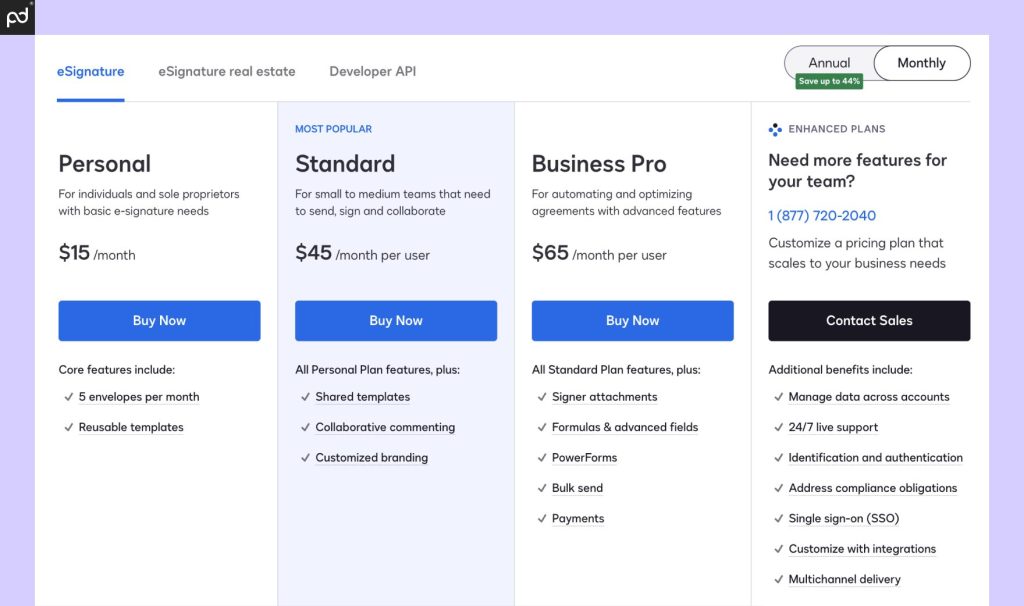
Requirements, workflows & pricing
Although both DocuSign and Xodo Sign approach the problem of digital signatures in separate ways, many of the basic workflows and requirements are the same.
DocuSign offers an industry-standard workflow and e-signing experience. Users will upload finished documents to the platforms, where users will prepare them for e-signature using drag-and-drop tools.
Prepared documents are sent to signatories for digital signing and, once the process completes, are stored within the DocuSign platform for easy access retrieval.
This is also the case for most other signing platforms.
Senders will receive notifications at every stage of this process, and signer activity is tracked and recorded via audit logs for later review.
One key difference between Xodo Sign and DocuSign comes down to platform availability.
With DocuSign, users can sign documents via a mobile app — available for both Android and Apple iOS platforms — or by accessing the website directly.
Xodo Sign users can access a mobile-optimized website, but no mobile app is available.
Once documents have been signed, they’ll remain inside the DocuSign platform for fast and easy access.
DocuSign provides some document management tools to help users keep track of information.
Signed documents and related documentation like audit trails can also be exported and stored offline.

Overall, Xodo Sign users will see an experience similar to DocuSign users.
The workflow and signing processes are largely the same in the sense that documents must be uploaded, prepared, and sent.
Xodo Sign starts to vary when considering minor and/or additional features.
Overall, this platform offers fewer turnkey solutions than DocuSign for users who need to move beyond basic e-signing functionality.
Features like form creation and payment gateways simply aren’t available with Xodo Sign, which further restricts the product use case and lowers versatility.
At the same time, Xodo Sign’s plan features seats for multiple users. If you have the headcount to hit those limits, it’s a more cost-effective solution by a significant margin.
Our suggestion
The better fit between DocuSign and Xodo Sign will come down to how you intend to use your signature software within your workspace and how much you’d like to pay for that functionality.
Small businesses who just need a cost-effective e-signing solution will find Xodo Sign’s pricing difficult to ignore.
With the ability to drive costs as low as $7 per user/month, Xodo Sign represents a wallet-friendly solution for e-signing — especially considering that both are SaaS platform subscriptions.
On the other hand, medium-to-large businesses with specific teams may enjoy the added usability that DocuSign’s many services provide.
With onboard payment tools, robust integrations, and basic contract management solutions, DocuSign might be a better fit for that use case.
- DocuSign likely makes the most sense for SMBs who are looking for extendability in their e-signing solution and don’t mind higher costs.
- Xodo Sign is a better fit for budget-conscious organizations who need strong e-signing without the extra bells and whistles.
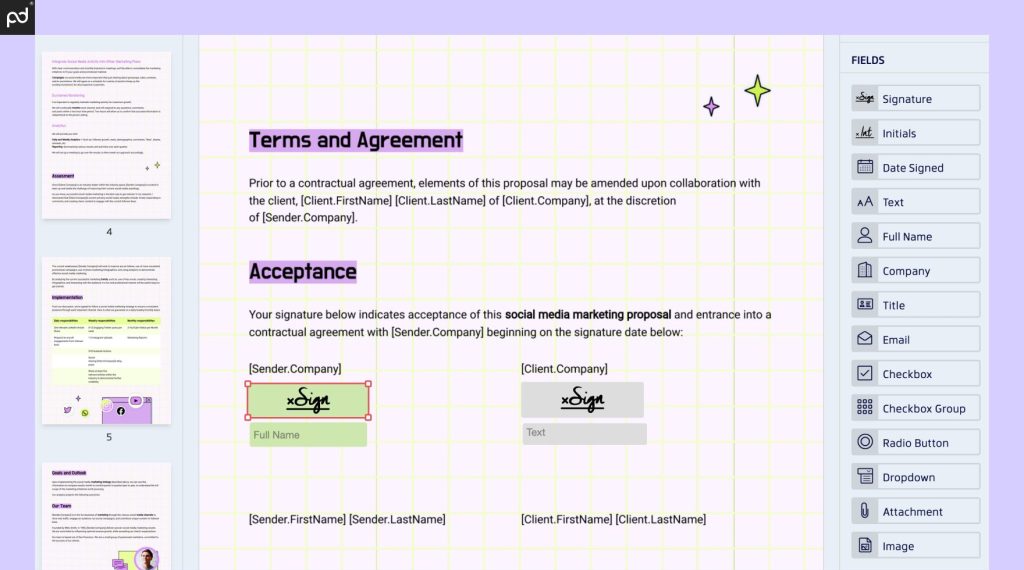
Document preparation & e-signing
On the surface, both Xodo Sign and DocuSign offer user-friendly interfaces and efficient e-signing processes.
Having tested both, we found Xodo Sign’s preparation environment to feel more polished and comfortable. Users will drag and drop boxes and signing fields onto a static PDF in order to prepare the document for signing.
These boxes vary by function and include everything from signer attachments to dropdown menus and radio buttons.
This functionality is enabled by default on every plan, which is notable because DocuSign gates advanced fields and features like signer attachments to its higher-end plans.
Xodo Sign users simply need to drag these fields onto their document, ensure that they’re assigned to the right recipient (in the case of multiple signers), and dispatch the document via the platform.
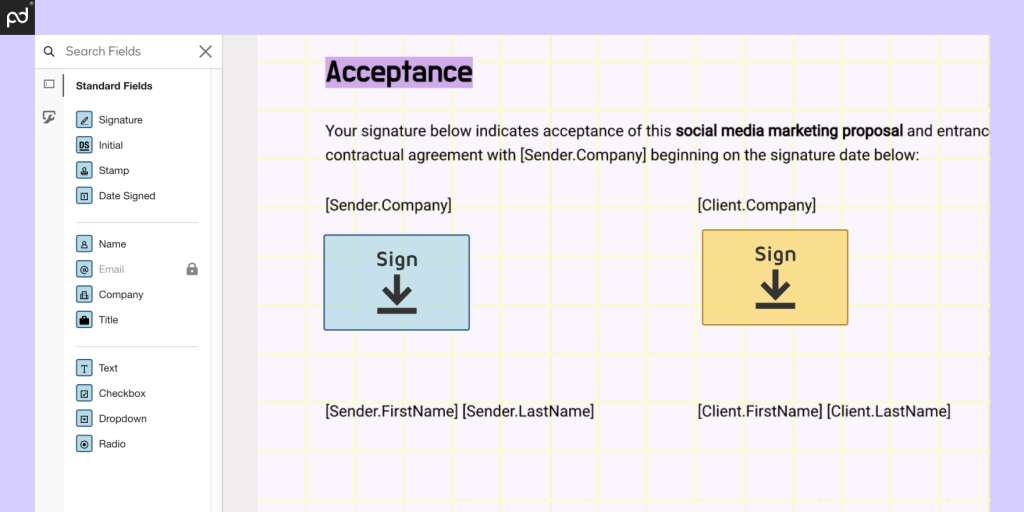
Preparation in DocuSign is similarly straightforward, although the experience carries a wider amount of variation by plan.
At lower tiers, DocuSign users will have access to basic fields like text boxes, dates, and e-signature blocks.
As users climb into higher tiers, greater functionality becomes available, far surpassing Xodo Sign in the process.
At the Business Pro tier, fields like drop-down and radio buttons become available (but these are available in Xodo Sign for all plans), as well as the ability to request payments and even add free-form drawing elements to your document (not available on any Xodo Sign plan).
But, as before, the availability of features comes down to cost. Outside of that, the preparation process is largely the same.
One element worth noting for larger organizations:
The document preparation process is greatly expedited by the creation of templates, especially for commonly used documents.
DocuSign doesn’t put a cap on templates while Xodo Sign limits the number of templates by plan.
Our suggestion
Overall, both DocuSign and Xodo Sign offer similar experiences with document preparation. However, DocuSign functionality varies greatly by plan.
Users on higher-end DocuSign plans will have access to a greater selection of functions and features than those on lower-tier plans while Xodo Sign users have access to the same tools at all plan tiers.
However, both platforms fill the same functional niche as document preparation tools.
This is different from document platforms like PandaDoc, which allow for from-scratch content creation as well as e-signature capture.
- Xodo Sign offers a more user-friendly approach to document preparation and provides a wider selection of tools to all plans.
- DocuSign’s features vary by plan. Users on higher-tier plans can do more than Xodo Sign users while those on lower-tier plans may lack some functionality.
- Neither platform goes beyond basic e-signing and document preparation processes. Platforms like PandaDoc are a better fit for those who want to do more with documents.
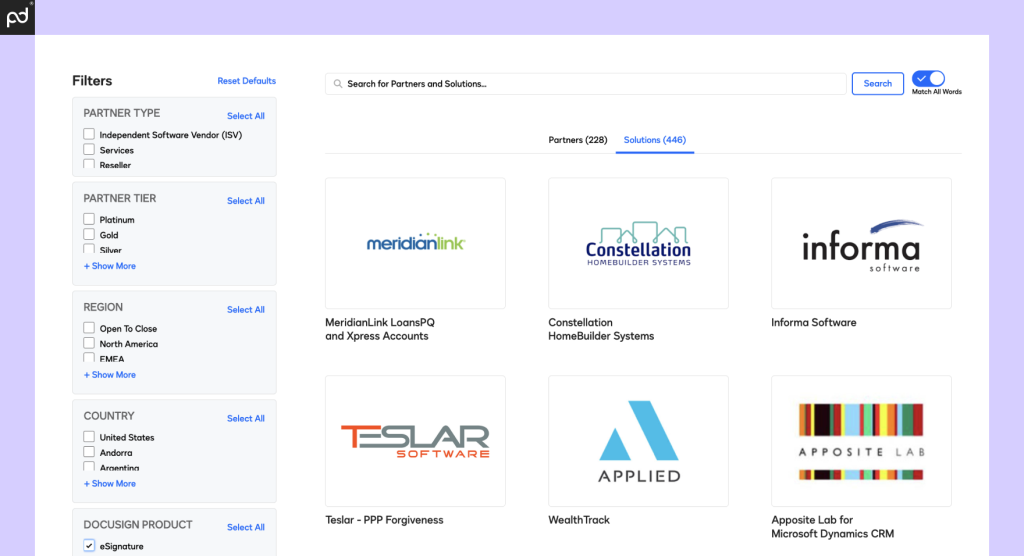
Automations & integrations
Both DocuSign and Xodo Sign offer automation tools to streamline your document workflow, but each platform approaches this process in different ways.
DocuSign offers a robust suite of automation tools aimed at optimizing document processes.
Features like conditional fields and form creation allow users to generate dynamic documents that are more flexible and adaptive than anything Xodo Sign can provide.
Templates are easy to create and are unlimited for every user.
You’ll also find that DocuSign integrates more readily with modern software solutions.
The platform has native integration options for hundreds of unique apps.
From Google Docs to Salesforce or HubSpot, it’s possible to connect DocuSign to nearly anything, further automating handoffs and leveraging the software far beyond the DocuSign platform. (Expect additional costs for this extendability.)
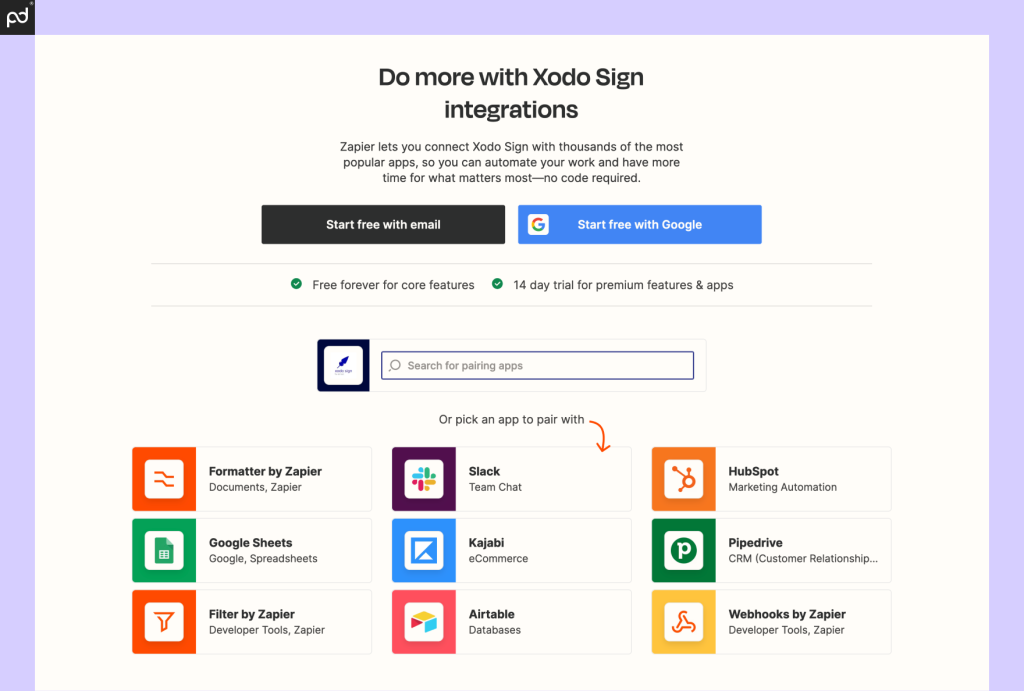
Compared to DocuSign, Xodo Sign is far more limited in its automation capabilities.
The platform only supports basic integrations with Google Drive, Microsoft OneDrive, Dropbox, and a few other storage services for document upload.
Everything else is left largely to the API or to third-party integration support via Zapier.
While this is fine for organizations willing to work through third-party services, it’s not as simple or straightforward as leveraging native connections within the application you intend to use.
On top of that, native integrations often provide additional functionality that may not be readily available via a third-party connector.
Unfortunately, Xodo Sign falls somewhat short in this area.
The issue may be resolved with API development, but that will require a separate service subscription, custom code, and some back-and-forth between Xodo Sign and the other apps in your tech stack that you intend to use.
Our suggestion
If your needs are complex, or if you manage intricate workflows involving multiple systems, DocuSign’s extensive suite of tools is likely a better fit.
However, if your automation needs are simpler and you value a more streamlined, user-friendly experience, Xodo Sign’s API and Zapier integrations might be sufficient.
Choose the platform that best aligns with your specific workflow requirements and technical expertise.
- DocuSign is better suited to complex workflows and teams who want to integrate with a robust tech stack.
- Xodo Sign has some integration options with Zapier and may work well for teams who have familiarity with API tools.
Alternatives to Xodo Sign & DocuSign
While Xodo Sign and DocuSign are well-established players in the e-signature market, they may not always be the perfect fit for everyone’s needs.
Here are a few alternatives to consider:
- PandaDoc
- SignNow
- Adobe Acrobat Sign (Formerly Adobe Sign.)
- Dropbox Sign (Formerly HelloSign.)
- OneSpan Sign
- SignRequest
Depending on your needs, other software options in the market may be a better fit.
Some apps offer more robust authentication protocols, different approval processes, or may be more heavily geared toward signing on mobile devices.
SignNow and SignRequest both offer a customizable approach to e-signing and the digital signature process while OneSpan Sign is more security conscious.
Platforms like PandaDoc even allow for robust content creation that goes far beyond anything DocuSign or Xodo Sign can do.
We’d suggest taking a look around before you commit to any one platform.
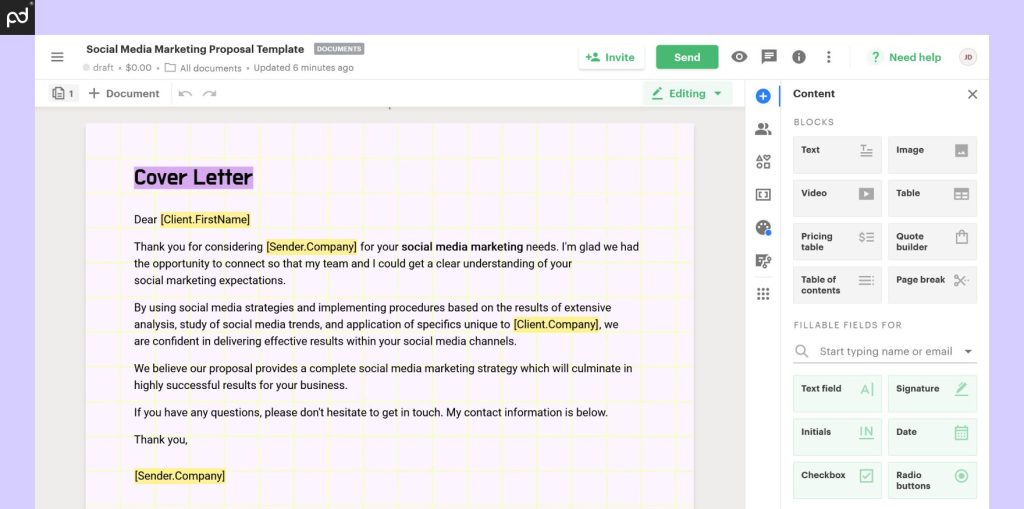
Better signatures & docs — with PandaDoc
Selecting the ideal e-signature solution between DocuSign and Xodo Sign can be challenging.
Both platforms offer unique advantages and drawbacks while addressing similar document process needs.
If you’re seeking a more balanced approach combining functionality, affordability, and ease of use, PandaDoc might be the optimal solution.
Here’s a closer look at what we offer:
- Powerful document creation. Create professional-looking documents completely from scratch.
- Advanced workflows. Automate document routing, approvals, and reminders to eliminate manual tasks and reduce errors.
- Seamless e-signing. Collect legally binding e-signatures on any device. Includes real-time tracking and notifications.
- Extensive integrations. From CRMs to productivity tools, add your document workflow to the rest of your tech stack.
- Affordable pricing. Choose a plan that fits your budget and scale as your business grows.
Don’t just take our word for it!
Read our customer reviews, schedule a personalized demo, or sign up for a free 14-day trial to experience firsthand how PandaDoc can revolutionize your entire document workflow.
Disclaimer
PandaDoc is not a law firm, or a substitute for an attorney or law firm. This page is not intended to and does not provide legal advice. Should you have legal questions on the validity of e-signatures or digital signatures and the enforceability thereof, please consult with an attorney or law firm. Use of PandaDocs services are governed by our Terms of Use and Privacy Policy.
Originally published January 28, 2022, updated September 5, 2024

